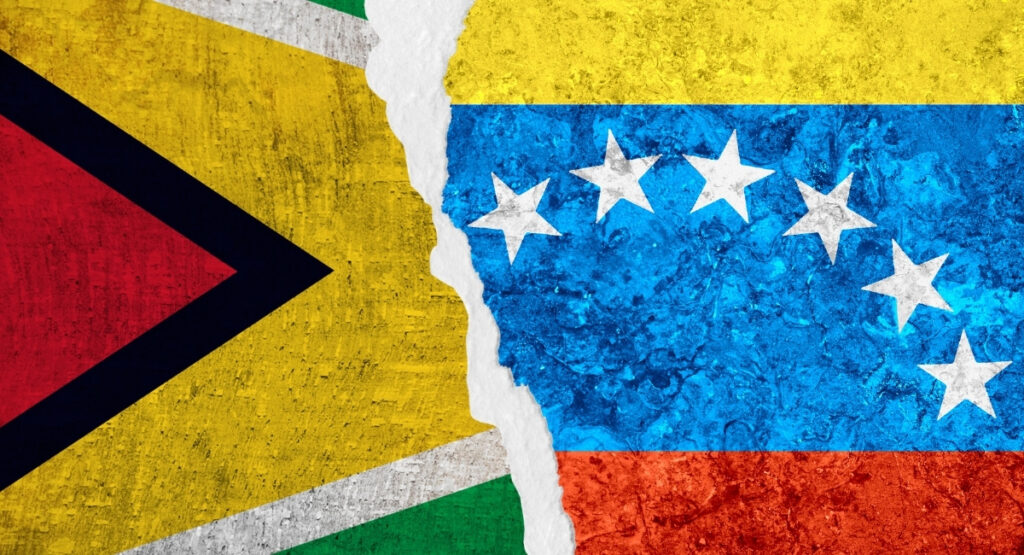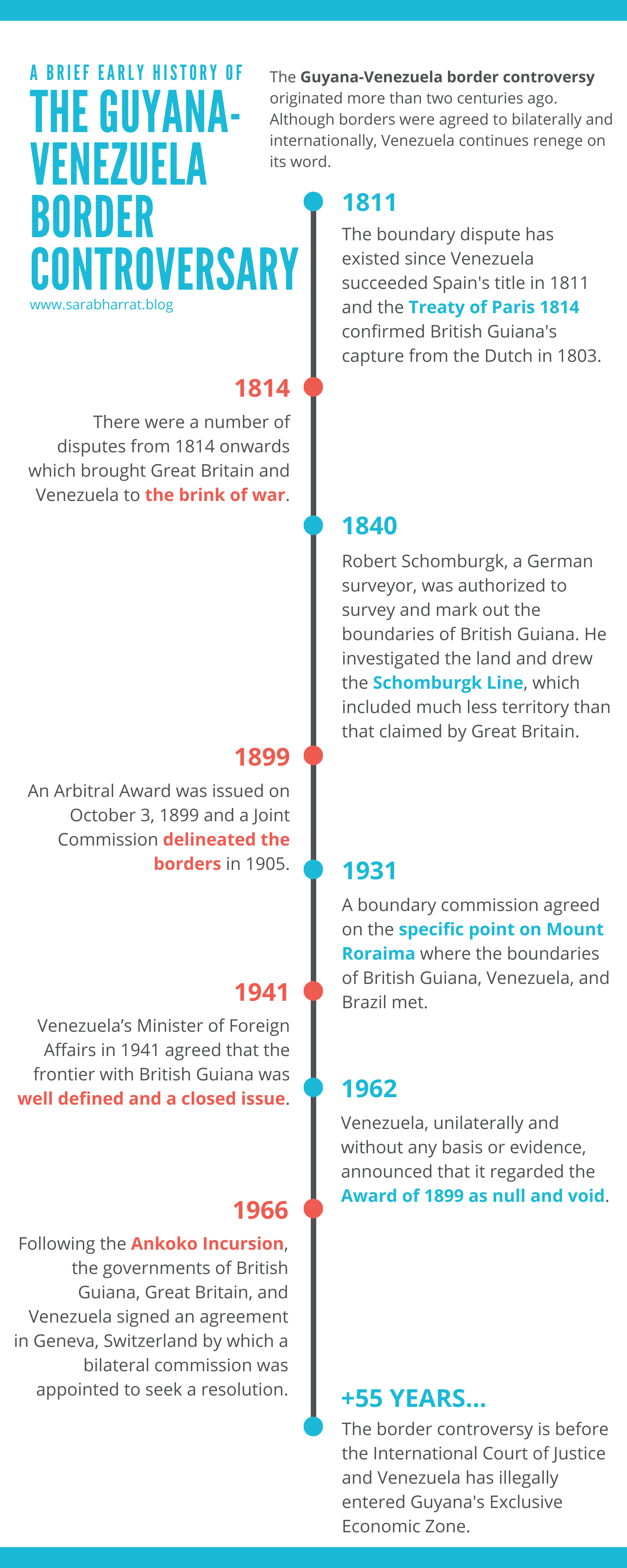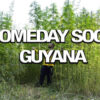This is a good article if you’re trying to get a basic understanding of the Guyana-Venezuela border controversy over the years.
The January 2020 capture of Sea Wolf and Lady Nayera and their crews by naval officers of Venezuela (Thomas n.p.) has signaled the country’s use of familiar military tactics. This is not the first time our western neighour has used such tactics against Guyana in the more than two century old border dispute. The gravity of the situation is more apparent when we consider that Venezuela is attempting to take, by force, for a second time “what has already been settled by treaty.” (Ince 6) The pressing question is ‘how far will Venezuela take the border dispute with Guyana this time’.
In 1962, Venezuela announced that the Award of 1899 which settled the border issue was null and void, after six decades of honoring the settlement with then British Guiana. Several years later in 1966, an armed group of Venezuelan soldiers and civilians, invaded and occupied territory on the Guyana side of the island of Ankoko. (Carmichael n.p.) Later, a Venezuelan naval craft was reportedly patrolling on waters outside the three-mile limit claimed by Guyana. (Ince 5)
On Sunday (January 24), Guyana’s Foreign Affairs Minister Hugh Todd said that the international community will be alerted about Venezuela’s latest actions. (Bryan n.p.) Minister Todd was scheduled to meet with his Venezuelan counterpart on Monday (January 25) at 4pm. As expected, the Minister Todd said the meeting was “cordial”, despite the warning Venezuela issued (Chabrol n.p.) to Guyanese against being active in their own area of coastal waters (Exclusive Economic Zone). In fact, Venezuela has continued its cordial approach by charging the crews of the Sea Wolf and Nayera for illegally fishing in their own waters.
This is just the latest jab from Venezuela. The country’s attacks on Guyana have continued into the 21st century with the unjustified killing of a Guyanese citizen by Venezuelan armed forces in 2006; the apprehension of a vessel conducting seismic studies in Guyana’s EEZ by the Venezuelan navy; protests to and threats against companies involved in economic partnership with the Government of Guyana; and the mobilization of military troops along the border with Guyana.” (Carmichael n.p.) When we consider the following citation of a New York Times report from 1968, it is almost as if history is repeating itself:
“A New York Times correspondent reported on August 12, 1968, that everything about the new city of Ciudad Guyana pointed toward a confrontation with Guyana: its increasing population, and its expanding industrial activity into which more than a billion dollars have been poured… In September 1966, Venezuela had occupied Guyana’s half of the island of Ankoko which is strategically situated on one of the border rivers between the two countries. The Guyanese representative has complained that Venezuelan armed forces have established on the island an airstrip capable of accommodating military aircraft.” (Ince 5-6)
Despite the growing tension, Venezuelans continue to cross the border into Guyana’s north-western region (Region 1). These displaced people are looking for food, shelter, and safety. Regional government and some development organizations have been providing support for more than two years. However, the region is under severe financial pressure as regional government continues to make its best effort to provide support. Regional Chairman of Region One Brentnol Asheley told Stabroek News on Sunday (January 24) that hundreds of Venezuelans continue to seek refuge in Guyanese communities because of constant attacks by the notorious Syndicato gang. (Sutherland n.p.)
Venezuela – Ranked high risk for crisis in 2021
At the peak of its economic growth after 1973, Venezuela’s oil revenues increased approximately four times to some US$9 billion annually. (Guy 508) This enabled the country to adopt a new style of foreign policy “aimed at the creation of a new international economic order and included funding the development programmes of Third World nations”. (Guy 508) In stark contrast several decades later, this year’s Preventative Priorities Survey ranked “accelerating economic collapse and political instability in Venezuela, leading to further violent unrest and increased refugee outflows” as one of the top conflict risks to watch in 2021. (Angelo n.p.)
Meanwhile, Foreign Policy has identified Venezuela, among several examples, as likely to face an increase in unemployment, a collapse of real incomes, mounting difficulties in government paying security forces, and increased reliance on state support at a time when the state is least equipped to provide it. “The lines separating economic dissatisfaction from social unrest, and social unrest from outbreaks of violence, are thin.” (Malley n.p.)
Currently, about 96% of Venezuelans live in poverty and the World Food Program estimates that one in three citizens does not have food security. (Angelo n.p.) These conditions along with Venezuela’s high levels of violence have contributed to about 5 million citizens fleeing in recent years. (Angelo n.p.) These conditions mean that Venezuelans will likely continue to seek refuge in Guyana and surrounding Latin American and Caribbean Community countries for some time yet. It is also likely that Venezuela’s present leaders are using its foreign policy as both a distraction and perhaps a solution to its domestic troubles.
In addition to the social and economic turmoil, Venezuela’s December 6, 2020 election has been described as a “missed opportunity for democracy” (EU urges dialogue in Venezuela to set up new elections n.p.). On Monday (January 25), the European Union called for broad political talks to set-up new elections and warned that it is ready to sanction senior officials if they undermine democracy or violate human rights.” (EU urges dialogue in Venezuela to set up new elections) Venezuela’s foreign policy is unlikely to improve before its political challenges are resolved.
Notes:
From Stabroek News journalist Thandeka Percival – “Guyana refers to the matter post 1899 as a controversy rather than a dispute.”
Works Cited
Angelo, Paul J. “Top Conflicts to Watch in 2021: Economic, Political, and Humanitarian Catastrophe in Venezuela.” cfr.org. Council on Foreign Relations, January 22, 2021. Accessed January 25, 2021. [https://www.cfr.org/blog/top-conflicts-watch-2021-economic-political-and-humanitarian-catastrophe-venezuela]
Bryan, Jarryl. “Int’l community to be alerted over Venezuelan violation of Guyana’s sovereignty – Foreign Minister.” guyanatimesgy.com. Guyana Times Inc., January 25, 2021. Accessed January 25, 2021. [https://guyanatimesgy.com/intl-community-to-be-alerted-over-venezuelan-violation-of-guyanas-sovereignty-foreign-minister/]
Carmchael, Stacey. “UPDATE: Timeline of Guyana/Venezuela border controversy.” dpi.gov.gy, Department of Public Information, January 31, 2018. Accessed January 25, 2021. [https://dpi.gov.gy/update-timeline-of-guyana-venezuela-border-controversy/]
Chabrol, Denis. “Venezuela warns Guyanese against future presence in waters off Essequibo.” demerarawaves.com. Demerara Waves, January 25, 2021. Accessed January 25, 2021. [https://demerarawaves.com/2021/01/25/venezuela-warns-guyanese-against-future-presence-in-waters-off-essequibo/]
“EU urges dialogue in Venezuela to set up new elections.” apnews.com. Associated Press, January 25, 2021. Accessed January 25, 2021. [https://apnews.com/article/europe-venezuela-elections-financial-markets-europe-b48e7678963087994a58cb4837c7d560]
Guy, James John. “Venezuela: Foreign Policy and Oil.” The World Today, vol. 35, no. 12, 1979, pp. 508–512. JSTOR, www.jstor.org/stable/40395094. Accessed 25 Jan. 2021.
Ince, Basil A. “The Venezuela-Guyana Boundary Dispute in the United Nations.” Caribbean Studies, vol. 9, no. 4, 1970, pp. 5–26. JSTOR, www.jstor.org/stable/25612170. Accessed 25 Jan. 2021.
Malley, Robert. “10 Conflicts to Watch in 2021.” foreignpolicy.com. Foreign Policy, December 29, 2020. Accessed January 25, 2021. [https://foreignpolicy.com/2020/12/29/10-conflicts-to-watch-in-2021-ethiopia-iran-yemen-somalia-venezuela/]
Sutherland, Laurel. “Region One under pressure from surge of Venezuelans.” stabroeknews.com. Guyana Publications Inc., January 24, 2021. Accessed January 25, 2021. [https://www.stabroeknews.com/2021/01/24/news/guyana/region-one-under-pressure-from-surge-of-venezuelans/]
Thomas, Marcelle. “Venezuela seizes two fishing boats off Waini.” stabroeknews.com. Guyana Publications Inc., January 25, 2021. Accessed January 25, 2021. [https://www.stabroeknews.com/2021/01/25/news/guyana/venezuela-seizes-two-fishing-boats-off-waini]
“U.S. Relations With Venezuela.” state.gov. U.S. Department of State, July 6, 2020. Accessed January 25, 2021. [https://www.state.gov/u-s-relations-with-venezuela/]
Disclaimer:
This article contains the personal views of the author and is in no way connected with any institution or group with which she may be affiliated.
A note from the Author:
Given the custom by various loyalists to misrepresent and misuse any type of political commentary to support their own positions, I feel that it is necessary to borrow the following from Thomas Paine (an English-born American political activist, philosopher, political theorist, and revolutionary) with whose work I became acquainted as a student of History at the University of Guyana:
Who the Author of this Production is, is wholly unnecessary to the Public, as the Object for Attention is the Doctrine itself, not the Woman. Yet it may not be unnecessary to say, That she is unconnected with any Party, and under no sort of Influence public or private, but the influence of reason and principle.
First Published: Craig Village, East Bank Demerara, January 25, 2021




